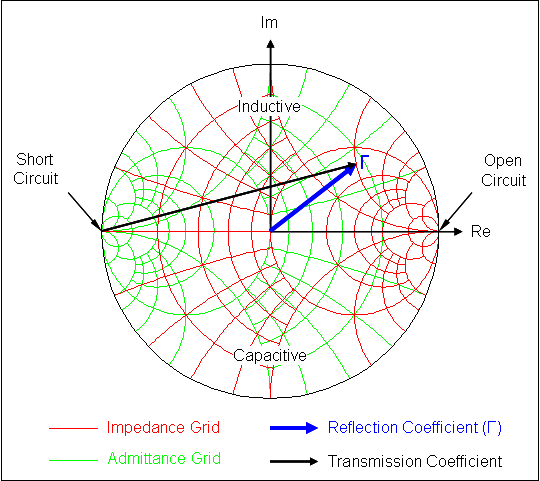

First, we need to shift the impedance back to the resistance axis by adding a series inductor with reactance of i0.7. In our example, suppose we need to match to a system impedance of 50 Ohms. Determining Impedance Matching From a Smith Chartīy adding some components, we can move the blue point, shown above, around the Smith chart until it sits at our desired impedance value:Īdding series L and C values shifts the point along constant resistance circles.Īdding parallel L and C values shifts the point along constant reactance curves.Īdding R expands or decreases the radius of a constant resistance circle. By measuring the required shift in the reactance and resistance, you can determine how large and what type of components are needed in a matching network. Determining impedance matching from a Smith chart requires comparing the plotted impedance to the source impedance. While this may seem like a very involved way to show an impedance value, there is more that can be determined from looking at a Smith chart. There is also a phase angle with respect to the origin of -110°. This point (shown in blue) is the impedance we want to plot. By tracing the curve back to the right-most origin, we find an intersection between the reactance curve and the resistance circle. Next, the reactance is determined by looking at the values along the outside of the chart. By tracing out a circle (shown in red) passing through the resistance axis, we are saying that all points on that curve have the same resistance. In this plot, the distance along the horizontal axis is used to denote the real part of the impedance. The image below shows an example Smith chart used to plot the impedance Z = 1.2 - i0.7 Ohms.

Suppose our unmatched load impedance is Z = 60 - i35 Ohms if the system impedance is 50 Ohms, then we divide the load and system impedances, giving a normalized impedance of Z = 1.2 - i0.7 Ohms. The system impedance might be a 50 Ohm transmission line. To start working with a Smith chart for impedance matching, we need to normalize our load component that requires impedance matching to the desired system impedance. However, some commercial applications and simulation tools will display impedance data in a Smith chart. As a graphical method for performing impedance matching, it was very useful before the time of graphical computers and simulation tools for plotting impedance.

This unique type of chart was developed by Philip Smith at Bell Telephone's Radio Research Lab in the 1930s. What Is a Smith Chart?Ī Smith chart is a type of graph used to plot the normalized impedance of a circuit, a circuit element, or an interconnect.
#HOW TO READ SMITH CHART HOW TO#
Smith charts are a standard tool used by many RF engineers, so it pays to know how to use a Smith chart for impedance matching. Using a Smith chart might seem complicated to new designers, and one might question why it is any more or less useful than a graph in Cartesian coordinates. In some cases, such as with transmission line stub matching in RF circuits or input impedance matching to a feedline’s characteristic impedance, a graphical representation of impedance can aid impedance matching.Ī Smith chart provides just such a graphical representation of impedance, and it is a useful tool for understanding how impedance varies in different systems. In many cases, you need to measure and carefully simulate the appropriate impedance required to ensure impedance matching and prevent power reflection. High speed and high frequency systems need impedance matching to ensure efficient power transfer and prevent reflections. Impedance matching in this PCB can be determined using a Smith chart Once impedance matching requirements are determined, the results can be simulated in a SPICE-based simulation application. One popular method for plotting impedance and determining impedance matching is to use a Smith chart. There are many methods for impedance matching in your circuits.


 0 kommentar(er)
0 kommentar(er)
